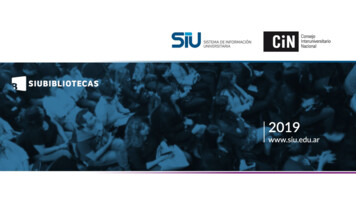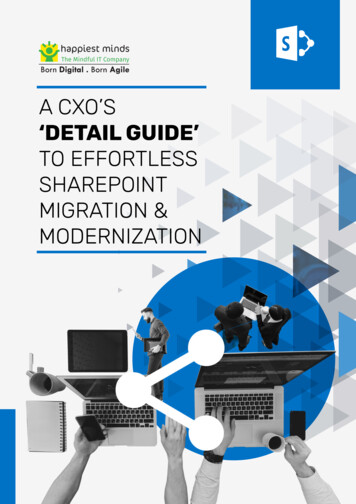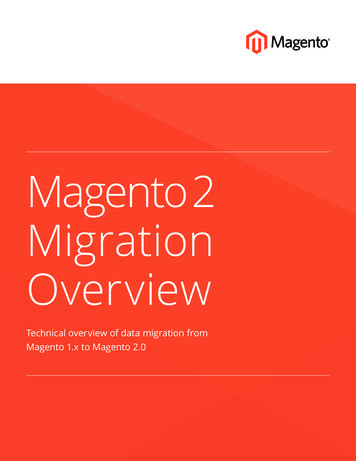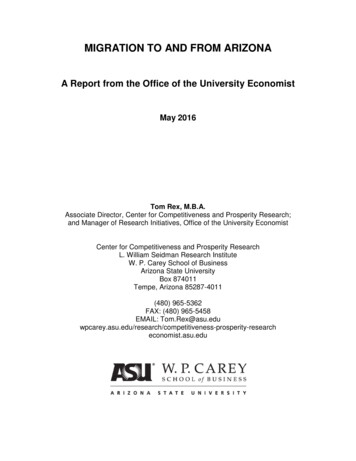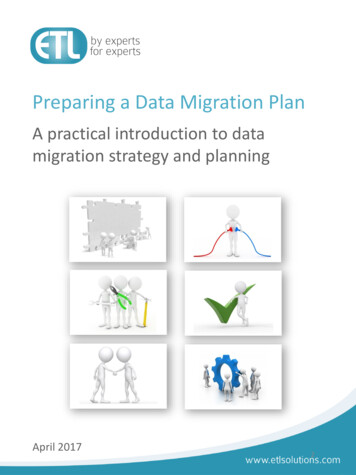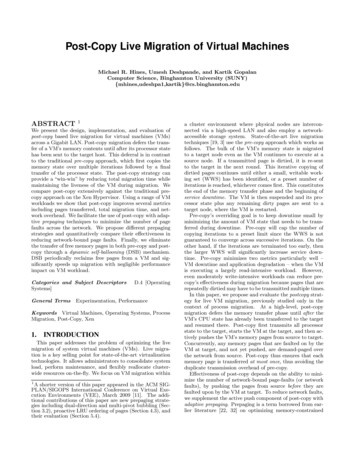
Transcription
Research Journal of Library and Information ScienceVolume 4, Issue 2, 2020, PP 42-46ISSN 2637-5915Migration from VTLS to KOHA Library Application Softwarein Ahmadu Bello University Library Complex: Reasons,Challenges and the Success StoryUmar Ibrahim1, John A. Ikwe2* and Abdullahi Abdussamad31Librarian Kashim Ibrahim Library Ahmadu Bello University Zaria, Kaduna NigeriaCataloger/Classifier, Resource Processing Divission, Kashim Ibrahim Library Ahmadu BelloUniversity Zaria, Kaduna Nigeria3Systems Analyst, Kashim Ibrahim Library Ahmadu Bello University Zaria, Kaduna Nigeria2*Corresponding Author: John A. Ikwe, Cataloger/Classifier, Resource Processing Divission, KashimIbrahim Library Ahmadu Bello University Zaria, Kaduna NigeriaABSTRACTProviding an overview of automation project and ILS migrations in Ahmadu Bello University Library, thepaper highlights reasons and challenges faced during the various switch over processes. Although the VTLSserved the library very well, the rising cost of the software associated with the increase in exchange ratenecessitated the library to immigrate from the software. The paper also discusses the critical challenge ofdata/record retrieval from VTLS to KOHA and how the university library system librarians were able toachieve that without losing any data/record. The paper concludes that the exercise have not only beenworthwhile but successful. Apart from empowering library staff with additional skills and knowledge, themigration led to increase in the number of records in the library management system and provides remoteaccess to library holdings via the Web leading to resources sharing and collaboration with other universitylibraries using KOHA nationally and globally.Keywords: Migration, VTLS, KOHA, Library Application Software, Ahmadu Bello University Library, ILS.INTRODUCTIONApplication of Computers to perform traditionallibrary housekeeping activities such as acquisition,circulation, cataloguing and serials controlsconnotes the concept of library automation.Automation dates back to the 16th century but thepresent successes are as a result of experimentsundertaken in the 1960s by the library of Congress.Automation causes changes in the way peoplecommunicate, locate, retrieve, and use information.Today, it is being embraced by many institutions,and thus it can be rightly said that a library is beingside lined if not counted as part of those making useof automation system in their individual libraries.Basically, library automation is achieved throughthe use of Integrated Library Systems (ILS) alsocalled Library Application Software (LAS). Thus,an automated library is one where computer is usedto manage one or several of the library’s keyfunctions. It should be noted as pointed out byMcMenemy (2006) that the whole essence ofembarking on library automation in universitylibraries is to enhance the need for the librariesto satisfy their clientele, particularly in providingorganized access to information stored in thelibrary and make it possible for these clientele tohave access to information stored in similarlibraries in Nigeria and the world over.APPLICATION OF INTEGRATED LIBRARYSOFTWARE IN AHMADU BELLO UNIVERSITYLIBRARY COMPLEXThe Ahmadu Bello University Library Complexis one of the largest library in Africa, south ofSahara. It has a large collection that is housed inthe main Kashim Ibrahim library at Samaru, aswell as in fourteen other satellite libraries. Nock(2006) reported that the library has about 1,200,000volumes, comprising books, non-book materials,journals, etc. The desire to have a system tomanage and provide easy access to this collectionbrought about the drive for deployment of librarysoftware. Therefore, according to Omoniwo(2001) the idea of library automation in theAhmadu Bello University Library started wayback as 1972 with the automation of its serialsrecord by the computer centre of the University.The need to undertake full library automation bythe Nigerian university was further exploited byResearch Journal of Library and Information Science V4 I2 202042
Migration from VTLS to KOHA Library Application Software in Ahmadu Bello University LibraryComplex: Reasons, Challenges and the Success Storya window of opportunity provided in 1989 whenthe World Bank provided funds to 30 federaluniversities in Nigeria for the acquisition of books,journals, and equipment, including computers.This encouraged the universities to embraceinformation and communications technologybecause the continued magnitude of informationresources being passed physically and on the webeach day presents an unprecedented challenge tothe profession in terms of traditional ways oforganizing, providing access to, and preservinginformation.of software use and migration in NigerianUniversity Libraries in which they discoveredthe practice among many academic libraries inNigeria that led to high turnover rate of use ofLAS in these libraries. Evidence in one of the studyshows that more than 75% of the Universitylibraries surveyed have migrated to more than onesoftware in less than six years in their automationproject, with most making use of seven types ofsoftware, namely TINLIB, GLAS, Alice forWindow, Lib (X-Lib), Virtua, E-Lib. SLAM andCD-ISIS.However, as pointed out by Bozimo (2006),serious automation efforts in Nigerian universitylibraries started in mid 1990’s, with the universitylibraries in Nigeria cashing in on the opportunitypresented by the World Bank project organizedand executed by National Universities commission(NUC) in the 1994/95 session to kick startautomation projects. NUC donated computers touniversity libraries in Nigeria and encouragedthem to acquire TINLIB software for theirautomation project. Unfortunately the use TINLIBsoftware in the Nigerian university libraries didnot last for long. Lack of adequate maintenancesupport and technical guide made most of theselibraries abandoned it early for other software. Inline with this Ahmadu Bello University Libraryadopted ALICE for Windows. Again, the use ofALICE for Windows software also suffered thesame fate as TINLIB software. ALICE forWindows software was criticized as being a schoollibrary system that did not meet internationalstandards. In addition, the institution generallysuffered from lack of reliable electrical systemsand had only 2MB or less bandwidth to theInternet. Therefore, these problems and others likefunding called for implementation of a newLibrary Management System Ahmadu BelloUniversity LibraryMany reasons have been attributed to this frequentswitch over. For instance, Adeyemi (2002)mentioned scarcity of systems analysts andabsence of dedicated commitment to automationon the part of the management, Adedigba andEzomo (2003) pointed out dissatisfaction with theeffectiveness of the existing software. While Imoand Igbo (2011), and Adogbeji, Nwalo, Vera andToyo (2013) attributed frequent change over toinadequate technical support for the software, highcost of maintenance and Nigeria universitieslibraries dependability on free and donated softwarefor their automation projects. Collaborating thesefindings, Iroaganachi, Durodolu and Omatseye(2016) and Dauda (2017) studies revealed lack ofin-depth feasibility study and testing of theproducts, restricted authorization for differentoperations, limits of access and lack of knowledgeof the procedural financial switching costs of ILSas some reasons ascribed to migration. Way back,Omoniwa (2001) argued that the big mistake madein the planning and execution of automationproject was that no budget back-up was providedfor the initial attempts. He also noted that the NUCinitiative for Federal Universities failed becausethe project was not backed up with fundingMIGRATION TO VTLS BY THE AHMADUBELLO UNIVERSITY LIBRARY COMPLEXA review of literature on LAS migration or whatsome literature term as switch over Dauda (2017)indicates the practice is not only limited to librariesin the developing countries. Wang (2009)conducted a survey of U.S. Academic Librarieswith Migration Projects in 2009. The studyprovides an overview of top ILS vendors that haveannounced ILS migration contracts, as well asopinions and insights from library directors,systems professionals, and other key personnel.Similarly, Imo and Igbo (2011) and Adogbeji,Nwalo, Vera and Toyo (2013) looked at challenges43It is interesting to note that this time AhmaduBello University Library took into considerationall the above mentioned reasons in migrating toVTLS with the view of avoiding any so thatsustainable software can be adopted. In theirstrategies for sustaining software use in NigerianUniversity libraries, Imo and Igbo (2011)suggested purchase after study and evaluation ofsoftware in question, collaborating with ICTbodies and experts to identify quality software andinvolving library staff and management insoftware acquisition. They further argued thatcollaboration with ICT bodies and experts inidentification of quality software will enhance thedevelopment and creation of cultural profiles forsocial groups of data/information or knowledgeorganizers, which will have the advantage ofResearch Journal of Library and Information Science V4 I2 2020
Migration from VTLS to KOHA Library Application Software in Ahmadu Bello University LibraryComplex: Reasons, Challenges and the Success Storyfacilitating the linking of these groups remotely toachieve the eventual goal of providing access toinformation for their various users. Also groupmembers are likely to operate on softwareplatforms that are the same or at least compatiblewith each other based on international metadatastandards.Chronic underfunding of higher educationaggravated by continued growth in studentenrollment and prolonged economic stagnationprompted the John D. & Catherine T. MacArthurFoundation and Carnegie to give the MortensonCenter for International Library Programs at theUniversity of Illinois a grant to provide professionaldevelopment and technical assistance to sixuniversity libraries in Nigeria. These universitiesare: Ahmadu Bello University, Zaria (ABU),Bayero University, Kano (BUK), University ofIbadan, Port Harcourt University (Port Harcourt),University of Jos, Obefemi Awolowo University.This grant was provided in 2006 and meant toimprove the information and access to theinformation needed for the researchers andstudents at each of the universities,(Breeding &Marshall, 2012)Although VTLS was a product of donor agenciesbut for the first time the selection of the softwarewas done by a team in which the universitylibrarians were fully involved. Following feasibilitystudy and identification of three best librarymanagement vendors; Ex Libris, Sirsi/Dynix andVTLS, a presentation was done by each to a teamconsisting of the representatives of the grantagencies and the librarians for the selection of thebest software. After the presentation and extensivedeliberations, Virtua a product of VTLS Inc. wasfinally selected and adopted by the six universitylibraries. Virtua was adopted because apart frombeing robust software with well developedfeatures, a lot of technical expertise work has beeninjected towards its development, which isespecially seen in the brevity of space for itsinterface and yet well designed to accommodatedata/record. No wonder Bozimo (2006) was soelated when Ahmadu Bello University Librarymigrated from Alice for Windows to Virtua,noting that the University library will be migrating“to more sophisticated software called the VTLS”IMMIGRATION FROM VTLS BY THE AHMADUBELLO UNIVERSITY LIBRARY COMPLEXThe indisputable qualities and richness of VTLShave no doubt endeared well not only toAhmadu Bello University Library but also to allthe other participating libraries. This is evidencein the number of years the libraries stayed with thesoftware. While some literature indicated mostlibraries using LAS for five years before switchingto another, all the participating libraries usedVTLS for more than ten years. Yet in spite of therichness of the features of virtua some problemsbegan to pop up as the usage progressed. Initially,out of the 20 units of Thin Client, (disklessworkstations used to access the OPAC) boughtwith the Macarthur fund, only ten were used andlater when the library upgraded the system they allbecame obsolete. The Sun server machinebrought in By JKK a computer hardware vendor inLagos hardly finished the first five years before itbroke down necessitating the University to use itsfunds to replace it with a new Dell server. Andbecause the new Dell system came with REDHat OS unlike the previous one with Sun Solaris,the Red Hat license was required to be paid forannually for support, again the university had tofund this (Uba 2015). The transition to this newsystem made the library to lose huge data.At take off of VTLS, the database usage Licensepermitted only 20 simultaneous users, meaningonly 20 people could log in at a time. Thisrestriction slowed down the retrospectiveconversion program whereas the library had onground very enthusiastic staff that was trained andwilling to make input into the database. Thelibrary went for an unlimited license at additionalcost. To rectify the fault on screen that always read“maximum user reached,’ which data entry staffbecame worried and another peculiar connectivityproblem in which constant Socket error would bedisplayed on the screen, the university had to payfor extra space in order to overcome thelimitations of these messages. In addition to theproblems listed above, the rising tide of exchangerate made it practically impossible for the libraryto cope with the continued subscription. Thus atthe expiration of the second five year subscriptionin 2018, the library could not raise the requiredfund for another renewal because the amount wasin the range of about forty eight million naira. It issad to note that it is this last singular problem thatmade Ahmadu Bello University Library and otherparticipating libraries to seek out for anothersoftware.REASONS AND CHALLENGES OF ADOPTINGKOHA BY THE AHMADU BELLO UNIVERSITYLIBRARY COMPLEXWhen it became inevitable for Ahmadu BelloUniversity Library to migrate to software, acommittee of well experienced library staff,Research Journal of Library and Information Science V4 I2 202044
Migration from VTLS to KOHA Library Application Software in Ahmadu Bello University LibraryComplex: Reasons, Challenges and the Success Storyparticularly those that worked with previoussoftware was set up. This committee was firstmandated to interact with the other five universitylibraries using Virtua with the aim of finding outtheir current situation. The committee was equallyrequested to carry out feasibility study, includinginviting vendors for demonstration; having inmind all the reasons attributed to softwaremigration, in order to select the best LAS for thelibrary that will over stay the period of VTLS.The committee dismayingly discovered that all theother participating university libraries have sinceabandoned VTLS, of course for the simple reasonof lack of funds to sustain the subscription. Theresult of the feasibility study recommended theadoption of KOHA software. Many literaturessuch as Vimal Kumar and Jasimudeen (2012) andOmeluzor, Adara, Ezinwayi, Bamidele and Umahi(2012) have provided reasons for the adoption ofKOHA software by libraries. Apart from Kohabeing web-based integrated library system capableof managing a wide range of administrativeprocesses typically found in modern libraries:cataloguing, authority management, serialsmanagement, circulation, acquisitions, reporting,etc, Koha is compatible with various internationallibrary standards, such as, MARC21, UNIMARC,MARCXML, ISO 2709, Z39.50, SRU/SRW, SIP2,RSS, etc.Another advantage of the software is that it isimplemented in thousands of libraries around theworld, from small personal libraries with a fewhundred items to large university libraries holdingmillions of items. Therefore, there is a vibrantcommunity of developers working to improveKoha’s security, stability and permanent with newfeatures coming out every year making it the mostadvanced open-source library system on themarket today. The fact that almost all the formerfive VTLS users have migrated to KOHA withmany Nigerian University libraries already onKOHA and more ready to join, made the choice ofthe software by Ahmadu Bello University Libraryimperative. By adopting KOHA, Ahmadu BelloUniversity Library can continue its cooperationand collaboration with the former members ofVTLS family, the other Nigerian Universitylibraries already on KOHA, as well the largercommunity of KOHA users globally.However the most critical challenge in adoptingKOHA faced by the Ahmadu Bello UniversityLibrary was the issue of data/records migrationfrom VTLS to the KOHA. The University libraryhas over the years of VTLS usage generated over45162,822 bibliographic records, 204,724 itemrecords bar coded and 3,866 in the Authority FileRecords. Therefore migration to any software thatwould not accept these records will make theautomation project of the library disastrous.Unfortunately all the software demonstrated failedin this regards. Initially KOHA also probe difficultbecause VTLS being proprietary software makesuse of ORACLE 10G OS whose maintenancefee was paid by the Vendor. It had somefeatures elaborately displayed while someothers were hidden. The interface differs fromthat of KOHA which uses My SQL OS.Because of the hidden nature of some of thefeatures of VTLS, the barcode fields/tags couldnot initially be extracted with the rest of theircorresponding records.Fortunately VTLS and KOHA make use of MARC21 format and one of the greatest advantages of theformat is its ability to present records whosestructure; identity and integrity do not changeor depreciate when transferred from one placeto other or from one system to the other. Theorganization of data within fields and subfieldsaccording to Ikwe (2008) and Das (2009) makeroom for specificity which facilitatesmanipulation and retrieval of data withinmachines. This advantage was brought to play inthe extraction of records from VTLS to KOHAby the university library systems librarian aftera careful study of the use of fields and their tagswith the catalogers. With repeated trials theextraction was completed and uploaded toKOHA. However, a locally defined tag wascreated for the barcode in KOHA. In addition,the system staff also created accounts in KOHAfor the patrons that existed in Virtua.THE SUCCESS STORYThe success story of migration from VTLS toKOHA by the Ahmadu Bello University Librarylies in the fact that no data/record was lost in theswitch over process. The process also did notlast long and VTLS was still in use during themigration, hence users did not suffer any denial.Apart from empowering library staff withadditional skills and knowledge, the migrationled to increase in the number of records in thelibrary management system so that users canfind and check out library materials makingpatrons to log on to the bibliographic databaseand make their searches as easily as possibleto obtain information on their needs. It canalso provide remote access to library holdingsvia the Web leading to resources sharing andResearch Journal of Library and Information Science V4 I2 2020
Migration from VTLS to KOHA Library Application Software in Ahmadu Bello University LibraryComplex: Reasons, Challenges and the Success Storycollaboration with other university librariesusing KOHA nationally and globally.CONCLUSIONThe paper discussed the application and frequentmigrations of ILS in Ahmadu Bello UniversityLibrary. Although VTLS served the library andother participating university libraries very well,the paper concludes that immigration from VTLShad to happen to all the participating universitylibraries and this time around funding was the onlymain reason ascribed to the switch over. Theability to retrieve all the data/records from VTLSto KOHA and joining the larger community ofKOHA users globally marks the success of themigration [6]Adedigba, Y.A and Ezoma E.O. (2003) Management of system migration African Journal of Libraryand information science Vol. 13. No. 1 Pp 33Adeyemi, B.M. (2002). Problems and challenges ofautomating cataloguing process at Kenneth DikeUniversity of Ibadan, Nigeria: Africa JournalLibrary and Information SciencesBenson Oghenevwogaga Adogbeji, Kenneth I. N.Nwalo, Okonoko, Ngozi Vera and DavidOghenevwogaga Toyo (2013) Software Migrationin Selected University and Special Libraries inNigeria International Journal of AcademicResearch in Business and Social Sciences 3 (4)Bozimo, Doris O. (2006). ICT and the AhmaduBello University Libraries. Nigerian Libraries:Journal of the Nigerian Library Association Vol. 120Breeding & Marshall (2012), Lib-web-cats,available at: l (retrieved 2 May 2012)Dauda, Idris Adamu (2017) Implications ofIntegrated Library Systems (ILS) SwitchingCosts in Nigerian University Libraries Unpublished M. Sc Thesis. Zaria: Department ofLibrary and Information Science, AhmaduBello University[12][13][14][15][16]Das, S. K. (2009). Fundamentals of MARC 21Bibliographic Format: New Delhi, ESS EssPublicationsIkwe, J.A (2008) MARC 21 and the Use of LinearSeparable Connectors Library and InformationManagement Forum Vol.12 no 1McMenemy, David (2006). Reviewing librariesand librarianship: what has changed in 80 years?Library Review, 56 (1 & 2) 8 – 11.Nock, G (2006) The Challenges of Computerising a University Library in Nigeria: The Caseof Kashim Ibrahim Library, Ahmadu BelloUniversity, Zaria. Library Philosophy andPractice Vol.Nwabuisi T. Imo and Uche H. Igbo (2011) TheChallenges of Software Use in Nigerian UniversityLibraries: Review of Experiences from 1990-2009Library Philosophy and Practice. Retrieved fromhttp://unllib.unl.edu/LPP/ on 10/3/2019Omoniwa, Moses A. (2001). The computerizationof the Kashim Ibrahim Library of Ahmadu BelloUniversity, Zaria 1972 – 2001. Nigerian Libraries:Journal of the Nigerian Library Association, 35 (I)15 - 22.Saturday U. Omeluzor, Olugbenga Adara,Madukoma Ezinwayi, A. Itunu Bamidele andFelicia Oby Umahi (2012) Implementation of KohaIntegrated Library Management Software (ILMS):The Babcock University Experience CanadianSocial Science 8 (4) pp. 211-221 DOI:10.3968/j.css.1923669720120804.1860Uba, Umar.(2015) VTLS - VIRTUA the Story soFar. A paper presented at the Committee Room ofKashim Ibrhim Library, Ahmadu Bello University,ZariaVimal Kumar, V and Jasimudeen, S (2012)Adoption and User Perception of KOHA LibraryManagement System in India Annals of Libraryand Information Studies, Vol. 59 pp 223 -230Zhonghong Wang (2009) Integrated LibrarySystem (ILS) Challenges and Opportunities: ASurvey of U.S. Academic Libraries with MigrationProjects The journal of Academic Librarianship, 35(3) pages 207-220Citation: Umar Ibrahim, John A. Ikwe and Abdullahi Abdussamad, “Migration from VTLS to KOHA LibraryApplication Software in Ahmadu Bello University Library Complex: Reasons, Challenges and the Success Story”,Research Journal of Library and Information Science, 4(2), 2020, pp. 42-46.Copyright: 2020 John A. Ikwe. This is an open-access article distributed under the terms of the CreativeCommons Attribution License, which permits unrestricted use, distribution, and reproduction in anymedium, provided the original author and source are credited.Research Journal of Library and Information Science V4 I2 202046
Ahmadu Bello University Library started way back as 1972 with the automation of its serials The need to undertake full library automation by the Nigerian university was further exploited by ABSTRACT Providing an overview of automation project and ILS migrations in Ahmadu Bello University Library, the



